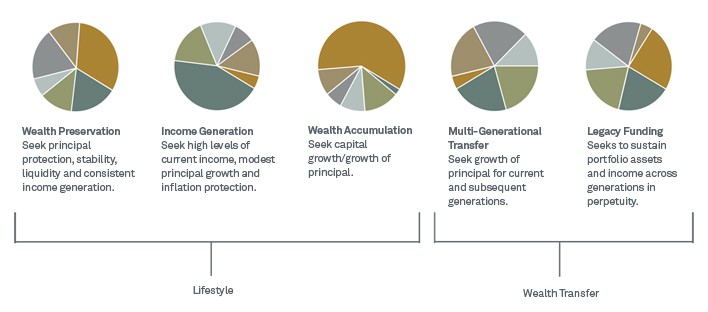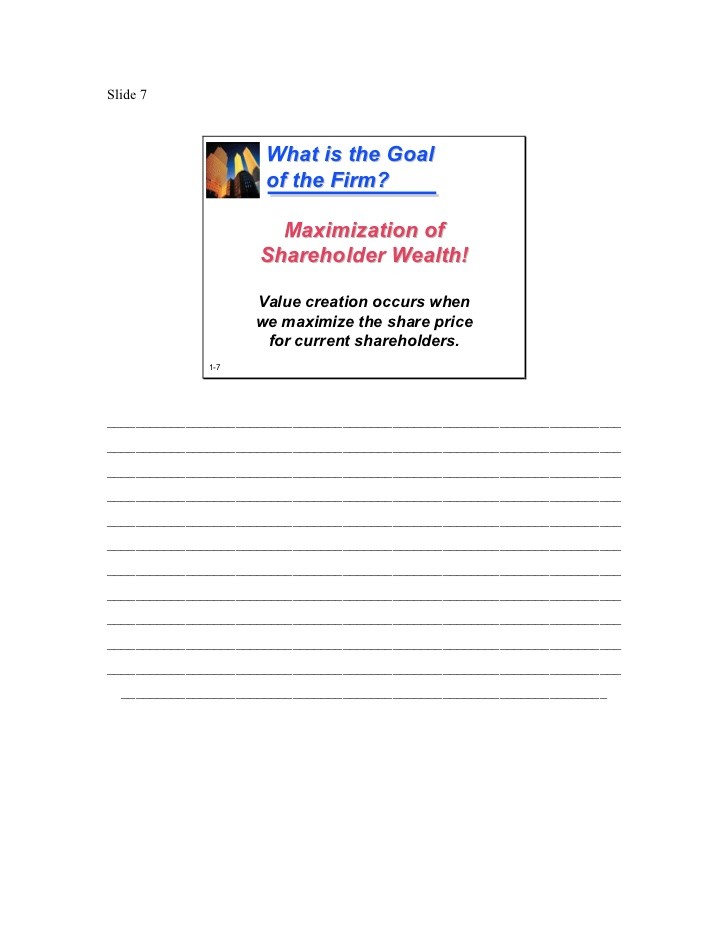The Goals in the Maximization of Wealth in a Business
Post on: 14 Апрель, 2015 No Comment

Most academics agree that shareholder wealth maximization should be a firms primary goal, wealth maximization is based on the concept of cash flows .cash flows are a reality and not based on subjective elements in the concept of profit maximization. It considers time value of money translates cash flows occurring of different periods into a comparable value of cash flows in considered critically in all decisions as it incorporates the risk associated with the cash flow stream. (Kalpana Rashiwala, February 2001,business times).
All though CEOs and directors are ultimately responsible for maximizing share holders value, they seldom if ever are exposed to valuation models, or even to data that focuses on long –term levels of stock prices as a reflection of future economic reruns and reinvestment rates. Managements and boards, by and large, do not have an adequate understanding of either the forecasting efficiency of the market, or the knowledgeable investors attentiveness to the long-term wealth creation or dissipation potential of their management decisions. in particular, management should adhere to making decisions to maximize long-term shareholder value regardless of the near-term effect on quarterly earnings.
Maximization of wealth and it relevant to companies financial objectives
The financial goal of the organization is how to maximize the shareholder wealth as reflected in the market price of the stock. In generally shareholders they like better more wealth to less wealth, so shareholders wealth maximization consisting with the long-term interests of stakeholders and society.
The main and important objective of maximizing shareholder wealth assumes that managers run in the best interests of stockholders, not for their selves, and do not try to appropriate wealth from lenders to benefit stockholders. Stockholder wealth maximization also measures that manager’s do not focusing and not taking any action to deceive financial markets in order to improve the price of the company’s stock. There is another assumption that managers do something in a responsible conduct and do not produce something that seems for unreasonable costs to society in detection of stockholder wealth maximization.
(Kalpana Rashiwala, February 2001,business times) assume that when financial manager assess potential to investment into a new product, they examine the risks and potential benefits and cost ,if the risk-adjusted benefits don’t outweigh the costs, they will not invest. Similarly, managers assess current investment for the same purpose; if benefits don’t continue to outweigh the cost, they don’t continue to invest the product but they will shift their investment elsewhere this is consistent shareholders wealth maximization and with the allocative efficiency of the market economy.
Material in the capital (that is conventional financial capital) dominated the era of industrial economy ,to maximize shareholder wealth enterprises often become the main objective of financial management ,because material capital investors are only investors are the only investors enterprises to meet the material capital investors desire to maximize wealth. Along with the development of material knowledge economy ,the scope of capital, there is a change in the new capital structure ,material, capital and human capital (intellectual capital) go hand in hand, the decision to change the enterprise of financial management objectives is no longer just attributable to shareholders, and shall be vested in a “main stakeholders” such as shareholders ,human capital investors, creditors, customers and so on, they are dedicated to the business of invested capital, the remaining enterprises have made contributions and thus have to share the remaining enterprises rights. Clearly the interests of all enterprises involved in the operation of enterprises are the interests of all and not just the interests of shareholders. in addition ,business survival the more social circumstances, enterprises cannot do without the support of the community, enforce social responsibility must also be the duty of the enterprise. therefore, enterprises must be innovative financial management objectives, must be from a single-to multi-oriented shareholder interests, by the maximization of shareholder wealth to meet objectives of the main interests of goals, experts in financial management have endorsed the view the main goal of financial management of the company’s is maximization of economic welfare of its shareholder .
Wealth maximization of shareholders is reflected in the market value of the company’s shares. when firms maximizing its value then firm’s role to society became maximized. So there are two types of the goals of financial management of the firm which are maximizing wealth and maximizing profit .
Agency problem and measures that helps companies to solve it
An Agent relationship is a relationship between the principal and agent, in which agency acts with the principal, in corporation the principal are the shareholders and the agents are the managers, there is a lot of problems with agency relationship that resulted with different interests between the shareholders and managers. for example
1. Agency may not expend with their best efforts
2. Agency may act with their own self interest
3. Agency may consume excessive perquisite.
Agency problem resulted by direct and indirect cost, monitoring cost. bonding cost, and residual losses.
Monitoring cost: are cost incurred by principal to monitor the actions of agents, e.g. annual report of share holders.
Bonding cost: are cost incurred by agents to insure they will act in the best interest of the principal.eg Building employment contract.
Residual losses: is the implicit cost when management and share holders cannot be aligned even when monitoring and bonding occurred.
As measured in (Jensen, C, M, American Economic Review), Agency problems exist in large organizations because conflicts of interest sometimes happen between stockholders and managers. In most large organizations, managers only have a small proportion of stock. they may take action to place their interests above those of the stockholders. for example ,managers may raise their personal wealth by rising their bonus ,salaries, option grants that is high possible ,and by raising their perquisites including un necessary expensive furnished offices. creditors and Stockholders also exists agency problem between them, stockholders possible to take action through their organization managers that affect the riskiness of the organization such as investing in more risky assets, and also increasing a organizations riskiness can negatively affect the safety of its debt.
Mechanism’s of Reducing the Interest of Stockholders and Managers:

Threat of dismissal: top line managers are focus to achieving certain performance standards. for example if they did not reach those standards then board of directors can change or dismiss these managers they unable reach those target standards, And their substitute or replacements will be more better effective in performing the best interest of the stakeholders than the former managers.
Direct shareholders intervention: outside investors, especially those having a large percentage of the corporation’s shares can effect and influence the firm’s activity and it decision by using their voting power
Managerial compensation: incentive compensation systems provide as one means of reducing the interests of mangers and shareholders. These systems can take many steps and consists by providing bonuses, salaries, performance shares, and stock option to motivate and reward by greater performance and to penalize and punish for the low and poor performance. And so changing managers into substantial owners is probable to reduce the happening of agency conflicts.
Shareholder wealth maximization and net present value
The shareholder wealth maximization goal states that management should endeavour to maximize the net present (or current) value of the expected future cash flows to the shareholders of the firm.net present value refers to discounted sum of the expected net cash flows .some of the cash flows, such as capital outlays, are cash outflows, while some, such as cash proceeds from sales, are cash inflows.net cash flows are obtained by subtracting a given periods cash outflow from that periods cash inflows. The discount rate takes into account the timing and risk of the future cash flows that are available from an investment. the longer it takes to receive a cash flow, the lower the value investors place on that cash flow now. The greater the risk associated with the cash flows expected to be received in the future cash flow, the lower the value investors place on that cash flow.
The shareholders wealth maximization goal, thus; reflects the magnitude, timing and risk associated with the cash flows expected to be received in the future by shareholders. in terms of the firms objective, shareholder wealth maximization has been emphasized because this book has a corporate focus.
(Peter Goldstein) measured that a simplified case where there is only one capital outlay which occurs at the beginning of the first year of the project, the net present value of the annual net operating cash flows (and the net terminal cash flows). If the capital outlay occurs only at the beginning of the first year of the project then it is already a present value and it is not necessary to discount it any further, so the shareholder value is maximized if only if the firm makes only those decisions that generate positive net present values.
Conclusion
The goal of the firm might well be expressed in terms of a truly inspiring mission statement to produce uniquely valuable benefits to particular consumers. Achieving its stated goal in an efficient manner maximazes shareholders value.
In other words how a firm maximazes shareholder value invariably rest with efficiency in using resources in fulfilling customers wants over time .that the expected eefects of activities on shareholder value are often difficult to quantify does not diminish the importance of this crucial economic compass ,and its shareholder value is maximized if and only if the firm makes only those decisions that generate positive net present value.














